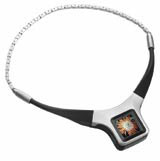Changing handsets sustain mobile market

‘We are addressing the mid-range directly, of course,’ says Sermon, referring to the new models. ‘But we have always focused on offering the greatest choice, rather than concentrating on niche [designs], which perhaps some of our competitors have. We have to make sure that the portfolio is both wide and deep.’
The designs launched this week are weighted toward the mid-range of Nokia’s portfolio. ‘A weighting toward the low-end is not a strategy, but may be an outcome. Unfortunately, we may not have maintained the balance as well as we would have liked,’ he adds.
An emerging sector for mobile manufacturers is wearable accessories. ‘True, wearable products is a key direction,’ says Iulius Lucaci, head of handset design for Motorola. ‘Jewellery, smart fibres and polymers that are comfortable and invisible are examples of [techniques] we are looking at.’
Nokia has developed medallion and choker ‘jewellery’ products that display images taken by a Nokia camera phone. At Motorola, Lucaci is also experimenting with new ‘materials combinations’, he says.
Networking and community-based features are also in the ascendancy. ‘We’re right at the cusp of mass acceptance of multi-mode products,’ Sermon says. He adds ‘We have to match the purpose and benefit of products with people’s attitudes and lifestyle.’
Global Market Share (per cent)
| Q1 2003 | Q1 2004 | |
|---|---|---|
| Nokia | 34.6 | 28.9 |
| Motorola | 14.7 | 16.4 |
| Samsung | 10.8 | 12.5 |
| Siemens | 7.6 | 8.0 |
| Sony Ericsson | 4.7 | 5.6 |
| LG | 4.9 | 5.3 |
| Others | 22.7 | 23.3 |
Source: Gartner, June 2004
-
Post a comment



